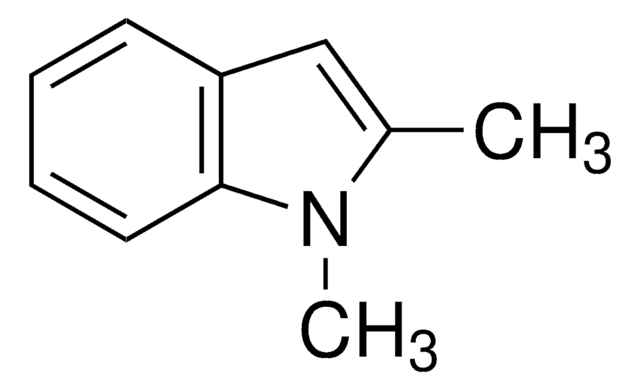All Photos(3)
About This Item
Empirical Formula (Hill Notation):
C9H9N
CAS Number:
Molecular Weight:
131.17
Beilstein:
111296
EC Number:
MDL number:
UNSPSC Code:
12352100
PubChem Substance ID:
NACRES:
NA.22
Recommended Products
Assay
98%
bp
265-266 °C (lit.)
mp
92-97 °C (lit.)
SMILES string
Cc1c[nH]c2ccccc12
InChI
1S/C9H9N/c1-7-6-10-9-5-3-2-4-8(7)9/h2-6,10H,1H3
InChI key
ZFRKQXVRDFCRJG-UHFFFAOYSA-N
Looking for similar products? Visit Product Comparison Guide
Hazard Statements
Precautionary Statements
Hazard Classifications
Aquatic Chronic 2
Storage Class Code
11 - Combustible Solids
WGK
WGK 2
Flash Point(F)
269.6 °F
Flash Point(C)
132 °C
Personal Protective Equipment
dust mask type N95 (US), Eyeshields, Gloves
Certificates of Analysis (COA)
Search for Certificates of Analysis (COA) by entering the products Lot/Batch Number. Lot and Batch Numbers can be found on a product’s label following the words ‘Lot’ or ‘Batch’.
Already Own This Product?
Find documentation for the products that you have recently purchased in the Document Library.
Customers Also Viewed
Mechanisms of 3-methylindole pneumotoxicity.
G S Yost
Chemical research in toxicology, 2(5), 273-279 (1989-09-01)
Daniel Mörlein et al.
Meat science, 91(4), 435-440 (2012-03-27)
The prevention of unpleasant boar taint is the main reason for castration of male piglets. For animal welfare reasons, castration is announced to be banned in the European Community. This study aimed to investigate whether androstenone, skatole and indole in
B Marcos et al.
Meat science, 95(3), 688-693 (2012-11-28)
Expression of water soluble proteins of fresh pork Longissimus thoracis from 4 pure breed pigs (Duroc, Large White, Landrace, and Piétrain) was studied to identify candidate protein markers for meat quality. Surface-enhanced laser desorption/ionisation time-of-flight mass spectrometry (SELDI-TOF-MS) was used
James B Y H Behrendorff et al.
Chemical research in toxicology, 25(9), 1964-1974 (2012-08-21)
Cytochrome P450 2F1 (P450 2F1) is expressed exclusively in the human respiratory tract and is implicated in 3-methylindole (3MI)-induced pneumotoxicity via dehydrogenation of 3MI to a reactive electrophilic intermediate, 3-methyleneindolenine (3-MEI). Studies of P450 2F1 to date have been limited
K M Bekaert et al.
Meat science, 92(4), 382-385 (2012-06-06)
Three potential early-age predictors of which boars are likely to develop boar taint (testes volume, skin lesions and dirtiness) were measured on 102 boars every fortnight from 10 weeks of age until slaughter. These predictors were correlated with the level
Our team of scientists has experience in all areas of research including Life Science, Material Science, Chemical Synthesis, Chromatography, Analytical and many others.
Contact Technical Service








